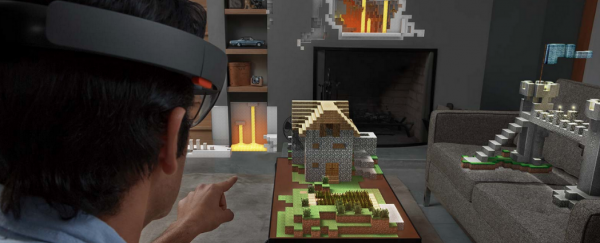Invented by Alex Kipman, the man behind Xbox Kinect's voice-response technology, the wireless HoloLens will create a kind of augmented reality for its users, where holographic images can be mapped onto anything you like - your walls, your kitchen counter, your desk, and even the air around you.
Watch the video above, and you'll see the technology being used to design a life-sized model of a motorbike, teaching home plumbing over Skype, and playing the most amazing game of Minecraft you could ever imagine. The technology is said to track the position of the user's hands at any given moment, which means you can grasp holographic images and move them around wherever you like. You can project three-dimensional weather forecasts onto your counter, and your email interface on your fridge. If Microsoft has it their way, you'll never take this thing off.
Which, of course, raises some interesting questions. As DJ Pangburn writes at Motherboard:
"While Microsoft believes HoloLens will become a new engine of creation and communication, with developers creating apps that exploit the headset's depth camera, the blending of realities will result in people spending more time, if not staring at an actual screen, computing nonetheless.
As we've seen with the ubiquity of mobile devices, there has been an erasure of offline and online existence. With virtual objects, interfaces, and experiences mapped onto the territory of our analog worlds, the obliteration of the line separating our offline or unplugged lives from our online ones will only be amplified."
The whole thing is pretty out-there, but it kinda has to be to change the future. Jesse Hempel at Wired was lucky enough to get a hands-on trial with the HoloLens, and describes the prototype as "amazing".
Hempel describes how the depth camera has a field of vision that spans whopping 120 by 120 degrees, so you can stretch your arms out as far as you like, and the HoloLens will have no problems tracking them. Sensors in the headset communicate with the system at a rate of several terabytes per second, but the computer won't feel hot on your head, because it's got air vents on either side to keep it constantly cool. Holograms can be adjusted using a set of buttons on the side of the device.
Head to Wired to read the prototype review. I can't wait for the augmented reality of tomorrow.
Sources: Motherboard, Wired
